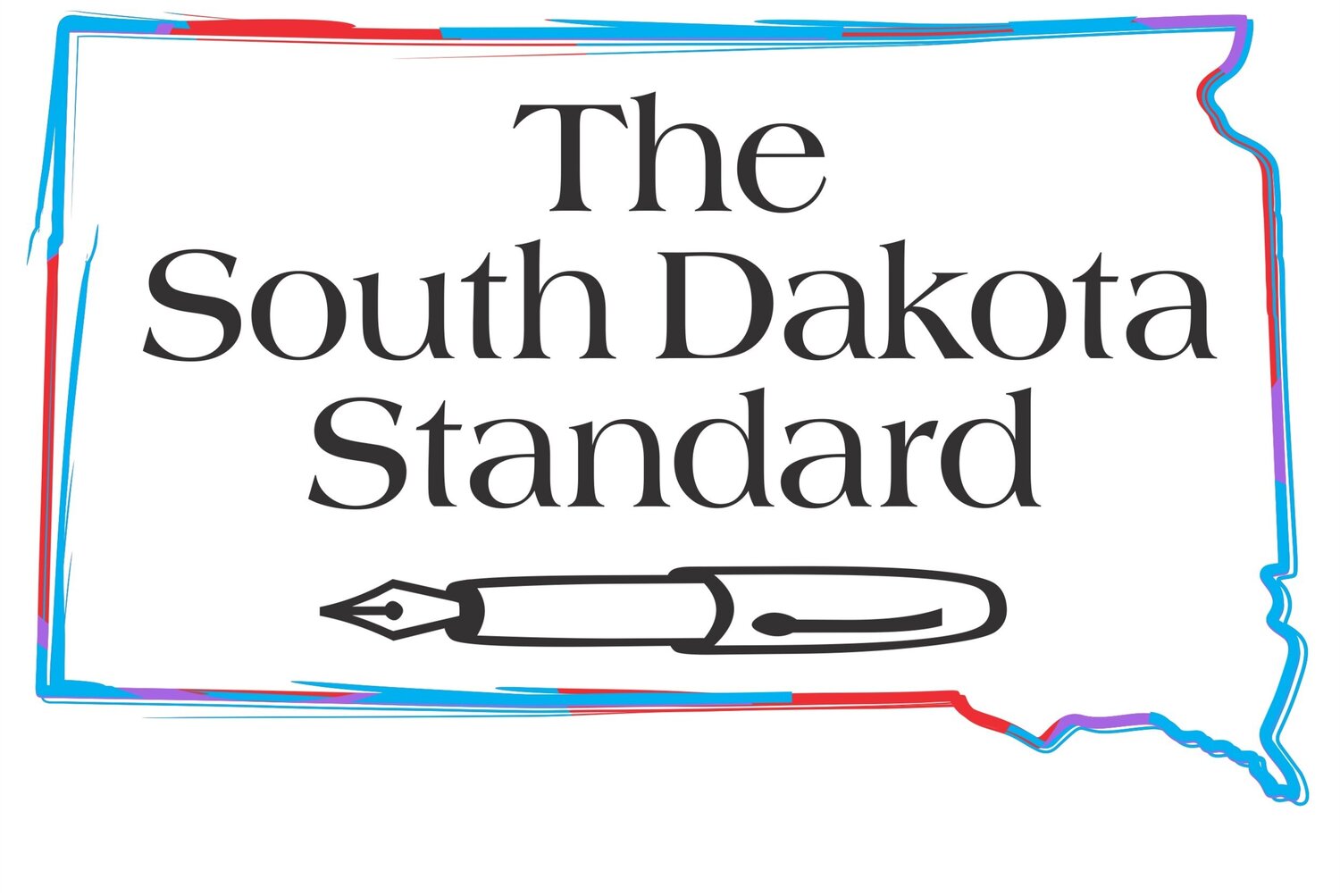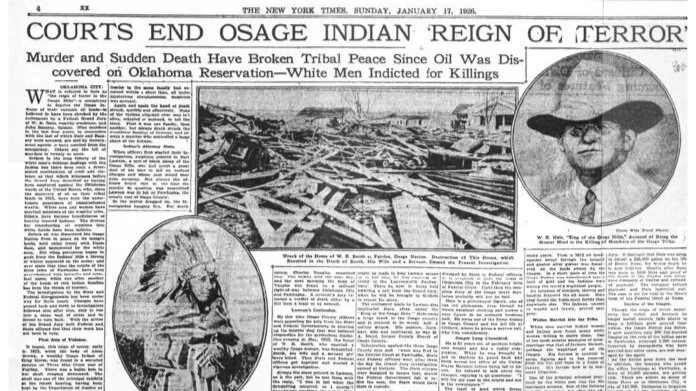‘Killers of the Flower Moon’ tells important history — but exploitation of Indigenous people continues today
It’s been a couple days since I saw “Killers of the Flower Moon,” a somber tale of a series of murders that became known as the Osage Reign of Terror (which made headlines, including the one above from the January 17, 1926, edition — now in the public domain — of the New York Times). I had the pleasure of reading the book by the same name by author David Grann.
I want to offer a few thoughts about the book and movie. I will try not to reveal anything significant that would detract from a viewer’s or reader’s enjoyment of either publication, but in case I inadvertently fail in that regard, please be warned now that you may want to avoid reading any farther until you see the movie and/or read the book.
But first, a bit of context.
“Killers of the Flower Moon” tells the story of the 1920s Osage murders that occurred following the discovery of oil on the tribe’s Oklahoma lands. The oil and the tribe’s legal successes that won its members the right to claim the “headrights” to the oil — which amount to a portion of the profits from the extraction of oil from their lands — made them some of the most wealthy people on Earth.
The book and film document the murder of Osage by greedy white men intent on stealing the headrights of tribal members. The book, like the movie, focuses on one Osage family that is impacted by these murderous thieves — the Burkharts.
But from here, the book and movie take divergent paths. While the book shifts its focus about halfway through to the role of the FBI in investigating the Osage murders, the film stays focused on the Burkharts, namely Mollie Burkhart and her white husband Ernest. In this regard, the book shifts to a typical white savior trope as it portrays the heroism of one FBI agent in finally ending, or at least slowing, the Osage murders.
The book is rich in historical context, though the film surpasses it in at least one way — it draws a comparison between the Osage murders and the 1921 Tulsa Race Massacre in which wealthy black business owners were targeted by white supremacists and others during a two-day riot that left somewhere between 75 to 300 people dead, mostly black people. Like the Osage murders, the Tulsa massacre featured white people preying upon a wealthy minority.
With that context, I will move into my review of the film, which will be fairly short so as not to give much away.
“Killers of the Flower Moon” by Martin Scorsese is a melancholic tapestry of a deeply troubled Oklahoma community where aspects of race and class wealth typical in most other American communities have been upended. Here we see white chauffeurs and maids serving wealthy Native men and women, but we also see a cottage industry that has been created by the Osages’ newfound wealth — one where nearly every aspect of this small Oklahoma community has been redesigned to take advantage of Indigenous wealth.
The film’s lead male character, Ernest Burkhart — played by Leonardo DiCaprio — is a World War I hero who has returned home to Pawhuska, Okla., to find it much changed by the discovery of Osage oil. He is recruited by his wealthy rancher uncle William “King” Hale, played by the legendary Robert De Niro, to become a driver for rich Osage Indians.
I’ll leave the rest of the plot for you to discover. But I will offer a few more thoughts about the film from my perspective as a Native man.
As an Indigenous person, it wasn’t hard to connect to the isolation experienced by lead actress Lily Gladstone’s character Mollie Burkhart, as her family becomes beset by mysterious deaths and murder. As Mollie walks through a crowd outside a train station en route to Washington D.C., where she plans to plead with national leaders to send help, she seems astutely aware that anyone in that crowd could be a murderer intent on her own demise.
But I would take this a step further and say that it wasn’t just paranoia that weighed down on Mollie Burkhart as she stared with great trepidation into the eyes of white men and women outside that train station. It was the burden that every man, woman and child of color carries as they traverse the public places of this world where they are clearly the minority. It is the thousand pinpricks our spirits experience from the curious and judgmental eyes of white men and women.
Let me say this: There are good white people. Many. Some have become such integral parts of our Indigenous communities that we call them family. I’ll go so far as to say we might not exist as a people if it weren’t for such white people, and I thank the creator for them each and every day.
But they are the exception, not the rule. And we as people of color must prove ourselves every day to those who don’t know us.
That is the isolation Mollie Burkhart feels as she begins to question every non-Native person around her.
This past Friday night, I saw an evening showing of “Killers of the Flower Moon” with more than 20 members of my local Native community, as well as many non-Native allies, and I have to say that this would have been a much more difficult and lonely experience if I hadn’t had so many people around me who felt as I felt — anxious and enraged at the violence inflicted upon the Osage people.
It took some amount of willpower not to stand up and shout at the screen, mostly out of a desire to challenge the feeling of powerlessness I felt at having to watch this tragedy unfold, this tragedy that I had no power to alter.
The 1920s Osage murders are over. Nothing can be done to change what happened, and the effects of those murders are still felt today. I would encourage you to follow Jim Gray, former principal chief of the Osage Nation, to learn more about those impacts.
But I will end this diatribe by saying this — the social and economic exploitation of Indigenous people continues today. After 24 years as a journalist covering Native America, I can tell you that I’ve documented countless ways that local, state and federal governments — as well as corporations and wealthy non-Native individuals — continue to prey upon Native communities and organizations.
From places like Whiteclay, Neb., where bootleggers and later beer store owners earned countless millions for several generations selling alcohol to tribal people, to Winnebago, Neb., where a wealthy tribal corporation continues to fight the state of Nebraska to hold onto the profits it earns from the sale of tobacco and gasoline, non-Native entities continue to attempt to fleece our Native people.
This must stop. We must learn to fight these people who seek to undermine our efforts to become strong and truly independent. And we must be willing to call upon and accept the help of non-Native allies to do so.
Suffice to say, I believe “Killers of the Flower Moon” should be seen by everyone. It recounts a little known chapter of American history that needs to be remembered, however difficult that task may be to Native and non-Native alike.
Wopilatanka.
Kevin Abourezk is the deputy managing editor of Indian Country Today and an award-winning film producer who has spent his 24-year career in journalism documenting the lives, accomplishments and tragedies of Native American people. He holds a bachelor’s degree in English from the University of South Dakota and a master’s in journalism from the University of Nebraska-Lincoln.







